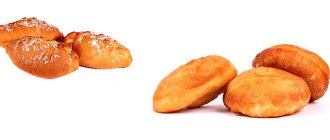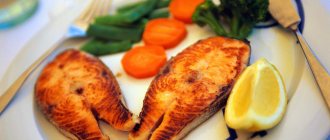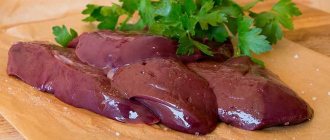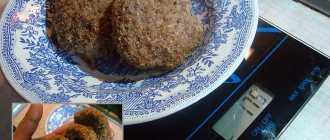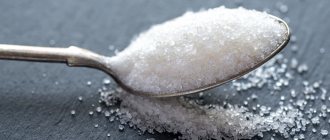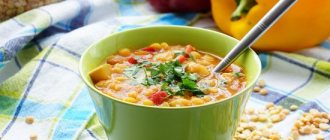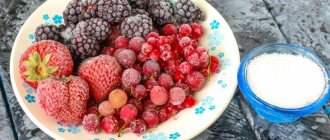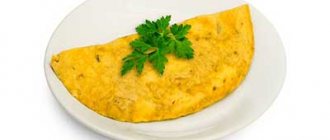Cottage cheese pancakes are a long-loved and familiar dish to us.
They often become the basis of a traditional breakfast. The classic cheesecake has a round shape, a thickness of 1.5 - 2 cm, a golden color and a delicate aroma. Its taste is determined by the ingredients, which can be vegetables, fruits, berries, seasonings and spices. You can store cooked cheesecakes without any health risks for 1 – 2 days in the refrigerator. This delicacy seems simple, but it is very capricious to prepare. The cheesecakes may not cook through, remain sticky inside, spread out in the pan, or become very dry. But, knowing all the intricacies of their preparation, you can avoid such consequences and prepare a tasty and healthy dish for your figure.
Losing weight with cottage cheese pancakes
Cottage cheese pancakes themselves, calorie content 1 pc. which is approximately 90 kcal (50 g, classic recipe), cannot be called a dietary product. But there are nutrition systems in which the dish is included as a product that helps successfully lose weight. This includes a hypocaloric diet, where it is recommended to eat several cheesecakes at breakfast. At the same time, you can reduce the calorie content of the dish by adding fresh fruit (instead of the usual sour cream).
What is a hypocaloric diet? This is what doctors now call the familiar term “Table No. 8”. This nutritional system is not just restrictive, but balanced in terms of the amount of fats, proteins, and carbohydrates for a person who does not burden himself with sports.
The list of foods allowed on a hypocaloric diet includes fruits, vegetables, cereals, low-fat protein sources, and vegetable oil. What is the minimum daily calorie intake? WHO recognizes the mark of 1200 kcal for the female body and 1500 for the male body. It must be taken into account that this refers to office employees who are obese.
There is also a version of the cottage cheese treat that, if consumed, will make weight loss impossible. Burger King cheesecakes of which is 392 kcal per serving.
Calorie content and methods of preparing cheesecakes
To prepare cheesecakes, products with the following calorie content are used:
- cottage cheese (with 18% fat content) – 236 kcal/100 g;
- flour – 334 kcal/100 g;
- butter – 743 kcal/100 g;
- chicken egg – 157 kcal/100 g;
- sugar – 399 kcal/100 g.
All these ingredients are combined in different volumes. The result is cottage cheese pancakes, the calorie content of which per 100 grams is about 330 kcal (including sour cream in the amount of 1 dessert spoon).
The nutritional value of the curd delicacy is reduced by some changes in the recipe. As an option, curds are prepared that do not require frying. Fresh cottage cheese is mixed with grated cucumbers, carrots and radishes. Balls from such a mass are served without resorting to heat treatment.
You can reduce the calorie content of cheesecakes by cooking them in the oven. As a result, they will be aromatic, rosy, tasty and at the same time less fatty.
By eliminating sour cream as a sauce and adding fruit (dried fruits) to the dough, you can prepare cheesecakes with raisins, the calorie content of which will be significantly reduced. Pear, banana, apple, and dried apricots will add a unique and refined taste to the curd dish.
The calorie content of cheesecakes fried in oil ranges from 270 to 370 kcal/100 g, depending on its quantity and the fat content of the cottage cheese.
Recipe for cheesecakes in the oven. Calorie, chemical composition and nutritional value.
Nutritional value and chemical composition of “Cheese cakes in the oven.”
The table shows the nutritional content (calories, proteins, fats, carbohydrates, vitamins and minerals) per 100 grams of edible portion.
| Nutrient | Quantity | Norm** | % of the norm in 100 g | % of the norm in 100 kcal | 100% normal |
| Calorie content | 186 kcal | 1684 kcal | 11% | 5.9% | 905 g |
| Squirrels | 16.8 g | 76 g | 22.1% | 11.9% | 452 g |
| Fats | 8.9 g | 56 g | 15.9% | 8.5% | 629 g |
| Carbohydrates | 9 g | 219 g | 4.1% | 2.2% | 2433 g |
| Organic acids | 0.9 g | ~ | |||
| Alimentary fiber | 0.3 g | 20 g | 1.5% | 0.8% | 6667 g |
| Water | 64.5 g | 2273 g | 2.8% | 1.5% | 3524 g |
| Ash | 0.986 g | ~ | |||
| Vitamins | |||||
| Vitamin A, RE | 87 mcg | 900 mcg | 9.7% | 5.2% | 1034 g |
| Retinol | 0.086 mg | ~ | |||
| beta carotene | 0.033 mg | 5 mg | 0.7% | 0.4% | 15152 g |
| Vitamin B1, thiamine | 0.055 mg | 1.5 mg | 3.7% | 2% | 2727 g |
| Vitamin B2, riboflavin | 0.29 mg | 1.8 mg | 16.1% | 8.7% | 621 g |
| Vitamin B4, choline | 85.36 mg | 500 mg | 17.1% | 9.2% | 586 g |
| Vitamin B5, pantothenic | 0.489 mg | 5 mg | 9.8% | 5.3% | 1022 g |
| Vitamin B6, pyridoxine | 0.119 mg | 2 mg | 6% | 3.2% | 1681 g |
| Vitamin B9, folates | 28.447 mcg | 400 mcg | 7.1% | 3.8% | 1406 g |
| Vitamin B12, cobalamin | 0.84 mcg | 3 mcg | 28% | 15.1% | 357 g |
| Vitamin C, ascorbic acid | 0.37 mg | 90 mg | 0.4% | 0.2% | 24324 g |
| Vitamin D, calciferol | 0.44 mcg | 10 mcg | 4.4% | 2.4% | 2273 g |
| Vitamin E, alpha tocopherol, TE | 0.404 mg | 15 mg | 2.7% | 1.5% | 3713 g |
| Vitamin H, biotin | 7.804 mcg | 50 mcg | 15.6% | 8.4% | 641 g |
| Vitamin K, phylloquinone | 0.1 mcg | 120 mcg | 0.1% | 0.1% | 120000 g |
| Vitamin RR, NE | 3.8016 mg | 20 mg | 19% | 10.2% | 526 g |
| Niacin | 0.453 mg | ~ | |||
| Macronutrients | |||||
| Potassium, K | 122.28 mg | 2500 mg | 4.9% | 2.6% | 2044 g |
| Calcium, Ca | 134.2 mg | 1000 mg | 13.4% | 7.2% | 745 g |
| Silicon, Si | 0.38 mg | 30 mg | 1.3% | 0.7% | 7895 g |
| Magnesium, Mg | 20.94 mg | 400 mg | 5.2% | 2.8% | 1910 |
| Sodium, Na | 57.17 mg | 1300 mg | 4.4% | 2.4% | 2274 g |
| Sera, S | 173.5 mg | 1000 mg | 17.4% | 9.4% | 576 g |
| Phosphorus, P | 209.3 mg | 800 mg | 26.2% | 14.1% | 382 g |
| Chlorine, Cl | 145.42 mg | 2300 mg | 6.3% | 3.4% | 1582 g |
| Microelements | |||||
| Aluminium, Al | 136.7 mcg | ~ | |||
| Bor, B | 3.5 mcg | ~ | |||
| Vanadium, V | 8.54 mcg | ~ | |||
| Iron, Fe | 0.906 mg | 18 mg | 5% | 2.7% | 1987 |
| Yod, I | 10.13 mcg | 150 mcg | 6.8% | 3.7% | 1481 g |
| Cobalt, Co | 2.872 mcg | 10 mcg | 28.7% | 15.4% | 348 g |
| Manganese, Mn | 0.0657 mg | 2 mg | 3.3% | 1.8% | 3044 g |
| Copper, Cu | 80.95 mcg | 1000 mcg | 8.1% | 4.4% | 1235 g |
| Molybdenum, Mo | 8.081 mcg | 70 mcg | 11.5% | 6.2% | 866 g |
| Nickel, Ni | 0.209 mcg | ~ | |||
| Tin, Sn | 10.13 mcg | ~ | |||
| Selenium, Se | 28.43 mcg | 55 mcg | 51.7% | 27.8% | 193 g |
| Strontium, Sr | 12.6 mcg | ~ | |||
| Titanium, Ti | 1.04 mcg | ~ | |||
| Fluorine, F | 36.68 mcg | 4000 mcg | 0.9% | 0.5% | 10905 g |
| Chromium, Cr | 2.48 mcg | 50 mcg | 5% | 2.7% | 2016 |
| Zinc, Zn | 0.5793 mg | 12 mg | 4.8% | 2.6% | 2071 g |
| Digestible carbohydrates | |||||
| Starch and dextrins | 6.443 g | ~ | |||
| Mono- and disaccharides (sugars) | 2.5 g | max 100 g | |||
| Essential amino acids | |||||
| Arginine* | 0.156 g | ~ | |||
| Valin | 0.152 g | ~ | |||
| Histidine* | 0.067 g | ~ | |||
| Isoleucine | 0.119 g | ~ | |||
| Leucine | 0.214 g | ~ | |||
| Lysine | 0.178 g | ~ | |||
| Methionine | 0.083 g | ~ | |||
| Methionine + Cysteine | 0.142 g | ~ | |||
| Threonine | 0.121 g | ~ | |||
| Tryptophan | 0.04 g | ~ | |||
| Phenylalanine | 0.129 g | ~ | |||
| Phenylalanine+Tyrosine | 0.223 g | ~ | |||
| Nonessential amino acids | |||||
| Alanin | 0.14 g | ~ | |||
| Aspartic acid | 0.243 g | ~ | |||
| Glycine | 0.083 g | ~ | |||
| Glutamic acid | 0.35 g | ~ | |||
| Proline | 0.079 g | ~ | |||
| Serin | 0.184 g | ~ | |||
| Tyrosine | 0.095 g | ~ | |||
| Cysteine | 0.057 g | ~ | |||
| Sterols (sterols) | |||||
| Cholesterol | 123.69 mg | max 300 mg | |||
| Saturated fatty acids | |||||
| Saturated fatty acids | 4.4 g | max 18.7 g | |||
| 14:0 Miristinovaya | 0.008 g | ~ | |||
| 15:0 Pentadecane | 0.002 g | ~ | |||
| 16:0 Palmitinaya | 0.405 g | ~ | |||
| 17:0 Margarine | 0.006 g | ~ | |||
| 18:0 Stearic | 0.174 g | ~ | |||
| 20:0 Arakhinovaya | 0.006 g | ~ | |||
| Monounsaturated fatty acids | 2.861 g | min 16.8 g | 17% | 9.1% | |
| 16:1 Palmitoleic | 0.077 g | ~ | |||
| 17:1 Heptadecene | 0.002 g | ~ | |||
| 18:1 Oleic (omega-9) | 0.809 g | ~ | |||
| 20:1 Gadoleic (omega-9) | 0.008 g | ~ | |||
| Polyunsaturated fatty acids | 0.611 g | from 11.2 to 20.6 g | 5.5% | 3% | |
| 18:2 Linolevaya | 0.217 g | ~ | |||
| 18:3 Linolenic | 0.012 g | ~ | |||
| 20:4 Arachidonic | 0.02 g | ~ | |||
| Omega-3 fatty acids | 0.1 g | from 0.9 to 3.7 g | 11.1% | 6% | |
| Omega-6 fatty acids | 0.7 g | from 4.7 to 16.8 g | 14.9% | 8% |
The energy value of cheesecakes in the oven is 186 kcal.
Primary Source: Created in the application by the user. Read more.
** This table shows the average levels of vitamins and minerals for an adult. If you want to know the norms taking into account your gender, age and other factors, then use the “My Healthy Diet” application.
Classic cottage cheese pancakes
Many housewives refuse to prepare this dish from cottage cheese due to an unsuccessful first experience - the cheesecakes either fell apart, were not baked, or spread in the pan. Use the classic recipe and this dish will become a traditional breakfast dish in your family.
The following ingredients will be required:
- cottage cheese in the amount of 0.3 kg;
- flour – 2 tbsp. l.;
- chicken egg (raw) – 1 pc.;
- sugar (optional) – 1 tbsp. l.;
- salt – 1 tsp;
- vegetable oil – 2 tbsp. l.;
- vanillin – 1 small pack.
How to cook correctly?
- Combine all ingredients except flour and butter.
- Sprinkle the table with flour and knead the resulting mass on it.
- Roll the dough into sausages and divide into equal lumps.
- We form balls and press them lightly until the desired shape is obtained.
- Roll the cheesecakes in flour to prevent them from burning.
- Pour vegetable oil into a frying pan and heat it.
- Fry the cheesecakes for 2 - 3 minutes until golden brown.
- Turn over and fry in the same way as the first side.
For better baking of the cheesecakes inside, it is recommended to cover the pan with a lid.
get a calorie content of cheesecakes of less than 200 kcal/100 g by preparing them only from low-fat cottage cheese.
Diet cheesecakes - recipe
Cheesecakes baked in the oven:
Components:
- Low-fat cottage cheese - 500 g;
- Semolina and flour - one tbsp each. spoon;
- Chicken egg whites – 4 pcs;
- A little dried apricots, cut into pieces;
- Raisins – 100-150 g;
- Half a banana;
- Soda on the tip of a teaspoon;
How to prepare dietary cheesecakes: mix all the ingredients, make balls with a diameter of 3-4 cm, and place them on a baking sheet covered with oiled parchment. The balls are baked for 30 to 40 minutes if the oven is preheated to 180 degrees.
Diet cheesecakes in the oven
The calorie content of baked cheesecakes is much lower than fried ones - 198 kcal/100 g. To prepare this dietary dish in the oven you will need:
- cottage cheese (low-fat) – 0.5 kg;
- banana (medium size) – 1 pc.;
- semolina (raw cereal) – 2 tbsp. l.;
- egg white – 2 pcs.;
- raisins or dried apricots – 2 tbsp. l.
Combine the listed ingredients, mix thoroughly, form balls from the resulting mass and place them on a baking sheet covered with baking paper. The preparation time for cheesecakes will be 15 – 20 minutes. The optimal temperature for baking is 180°.
Important! When preparing cheesecakes with semolina instead of flour, their calorie content will decrease, they will taste more tender and will get rid of stickiness.
Proper nutrition for weight loss: calorie content of cheesecakes in the oven
Cottage cheese and dishes prepared on its basis are distinguished by high nutritional value. To make a tasty and healthy breakfast very quickly, you can prepare cheesecakes in the oven, which are low in calories, but still contain many valuable ingredients.
Cheesecakes in the oven, whose calorie content is only about 198 Kcal per 100 grams of product, are very easy to make.
To do this, you need to buy cottage cheese, eggs, flour, sugar in advance. It is important to remember that the nutritional value of this dish largely depends on the choice of certain products and the ratio of components.
Cheesecakes with a calorie content of up to 200 kcal per 100 grams can be obtained only if low-fat cottage cheese is used. It can be bought in shops and supermarkets. When using fatty cottage cheese purchased from local farmers to prepare a dish, the calorie content of the dish increases to 300-310 Kcal.
The energy value of cheesecakes increases with the addition of large amounts of sugar and flour. If the housewife wants the dish to be dietary, she should add sugar and flour in minimal quantities to the cheesecakes. Sugar can be replaced with dried fruits. Prunes are excellent for these purposes. Before use, you need to soak it in water for 15-20 minutes and then cut it into pieces.
You can also add dried apricots to cheesecakes or completely abandon sweet additives, taking care of your figure. When serving, you can top unsweetened cheesecakes with jam or honey if one of the family members cannot live without sweets.
When greasing a baking tray with vegetable oil, the calorie content of cheesecakes increases. To avoid this, it is recommended to line the baking sheet with parchment or special foil. You can also use heat-resistant cookware with a non-stick coating.
To make the cheesecakes tender and light, you should bake them at a temperature no higher than 180 degrees. Typically, 20 minutes is enough to prepare this dish.
The calorie content of cheesecakes fried in a frying pan in vegetable or butter can be about 270-370 Kcal per 100 grams of product. The fattier the cottage cheese and the more butter, the more caloric the food will be.
This is why nutritionists do not recommend frying cheesecakes in a frying pan, especially since they can be cooked very tasty in the oven.
The dish can be served with special berry sauces. To prepare dietary cranberry or blackcurrant sauce, you need to add sugar and starch to the berries in minimal quantities.
Cheese pancakes with sour cream are very high in calories. Nutritionists do not recommend combining these products. If a person is on a fairly strict diet, it is better for him to eat 1-2 cheesecakes for breakfast. In the morning, metabolism accelerates, which allows food to be absorbed almost completely and not stored in the body as fat.
Cheesecakes should not be eaten for dinner if you are on a diet. It is better to replace them with fresh low-fat cottage cheese. Despite the low calorie content, cheesecakes still contain flour, which cannot be called a dietary product.
Cottage cheese contains a lot of calcium, which is very necessary for strengthening bones, which is very important for children and the elderly. It has been established that there is more calcium in low-fat fermented milk products, from which it is, moreover, much better absorbed.
Cheesecakes in the oven are a dish that has a relatively low calorie content and at the same time high nutritional value. When preparing cheesecakes, it is very important to use the right products to make the dish truly dietary.
Cheesecakes "Fitness"
The calorie content of cheesecakes made from 9 percent or completely fat-free cottage cheese is the lowest. For people who control their weight, this is the best option for preparing a dessert or main dish.
What will it take to create this unique dish?
- Cottage cheese – 200 g;
- buckwheat flour – 50 g;
- egg white – 2 pcs.;
- sugar substitute (stevioside) - to taste;
- rye bran – optional;
- coconut oil for greasing the pan.
The ingredients should be mixed until you obtain a mass that has a homogeneous consistency. With moistened hands, you need to form the cheesecakes, after which they need to be rolled in rye bran. Fry in a greased coconut oil and well-heated frying pan with a non-stick coating.
Secrets of delicious cheesecakes
Knowing the right recipe for a dish is good. But being aware of all the secrets of creating cheesecakes is the key to their successful preparation.
- Preparing cottage cheese. In order for the cheesecakes to be airy and soft, the cottage cheese must be rubbed to the consistency of a creamy paste. This can be done using a sieve or colander. Another option is to pass the cottage cheese through a meat grinder or grind it with a blender.
- Adjust the humidity of the cottage cheese. Be sure to get rid of excess whey. Otherwise, the cheesecakes will become rubbery. Reduce the moisture content of the cottage cheese by leaving it in a colander or gauze for a while to drain off any unnecessary liquid. If the cottage cheese is excessively dry, on the contrary, we moisten it by adding low-fat yogurt or kefir. Only if the cottage cheese has the correct consistency will your cheesecakes be tasty and juicy.
- We fry it correctly. Despite the fact that fried cheesecakes have the highest calorie content, this method of preparing them is the most popular. Not suitable for a weight loss diet, but if you use olive oil, it is acceptable. It is recommended to fry the cheesecakes over medium heat under a closed lid. The secret to creating a beautiful crust is to fry in oil, consisting of vegetable and butter in equal quantities.
Curd cheesecakes, the calorie content of which can vary significantly depending on the method of preparation and the components of the dough, can be included in the diet when losing weight. During the diet, it is worth experimenting by adding unusual fillings - zucchini, pumpkin, asparagus, cauliflower, herbs, poppy seeds, spices. Dried fruits and nuts will be a worthy addition to this curd delicacy.
In your family, what place do cheesecakes occupy in the diet? What do you like to use them with? Write in the comments your secrets for making cheesecakes and share new recipes.
Useful properties of cheesecakes
Undoubtedly, the most positive aspect of the dish is its exceptional taste, which will lift your spirits in the morning. However, in addition to this quite emotional useful property, there are also quite real ones.
Cottage cheese - this is the ingredient that prevails in this dish. Yes, it also contains other ingredients, but it is this calcium-filled ingredient that is very beneficial for people of any age.
Easily absorbed by the body, it helps to normalize work in many organs, as well as generally improve metabolism. If you suffer from kidney or liver disease, then cheesecakes can be the main element of your healthy start to the day. Despite the fact that cottage cheese is quite high in calories, in addition to calcium, it also contains phosphorus. Together they help strengthen bone tissue.
In addition to all this, it is in it that you can find milk fats and a fairly large amount of protein. At the same time, during the preparation of cheesecakes, cottage cheese practically does not lose its beneficial properties, so with the help of this ingredient you can normalize the functioning of the gastrointestinal tract.
Of course, these are not all the advantages that can be cited, but we must understand that this dish also has its negative sides.
